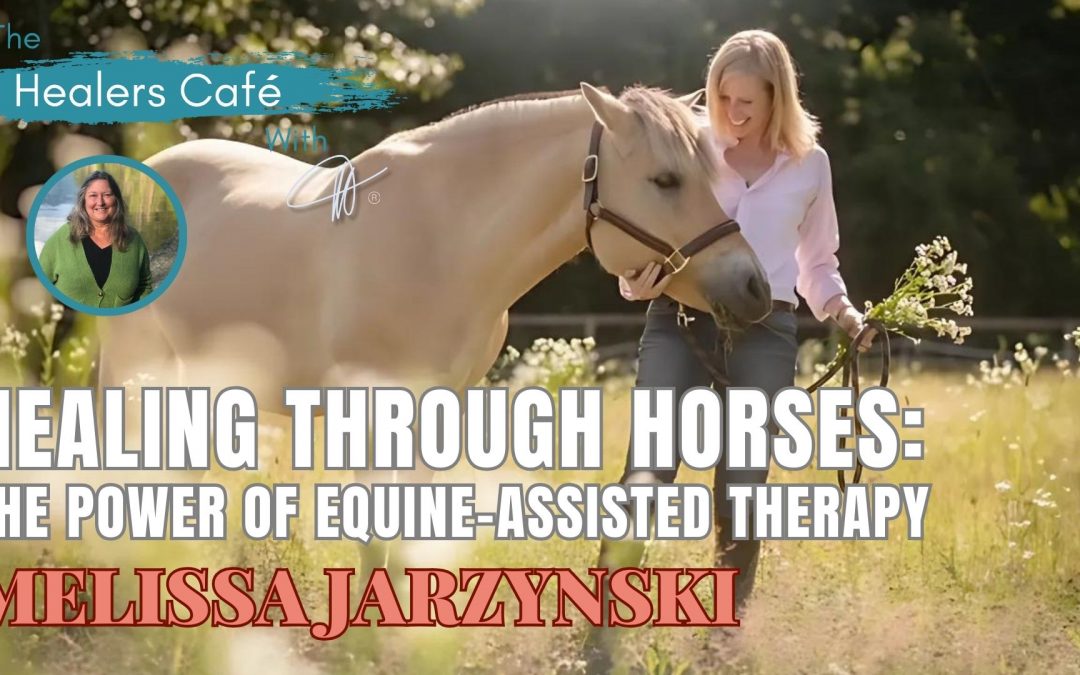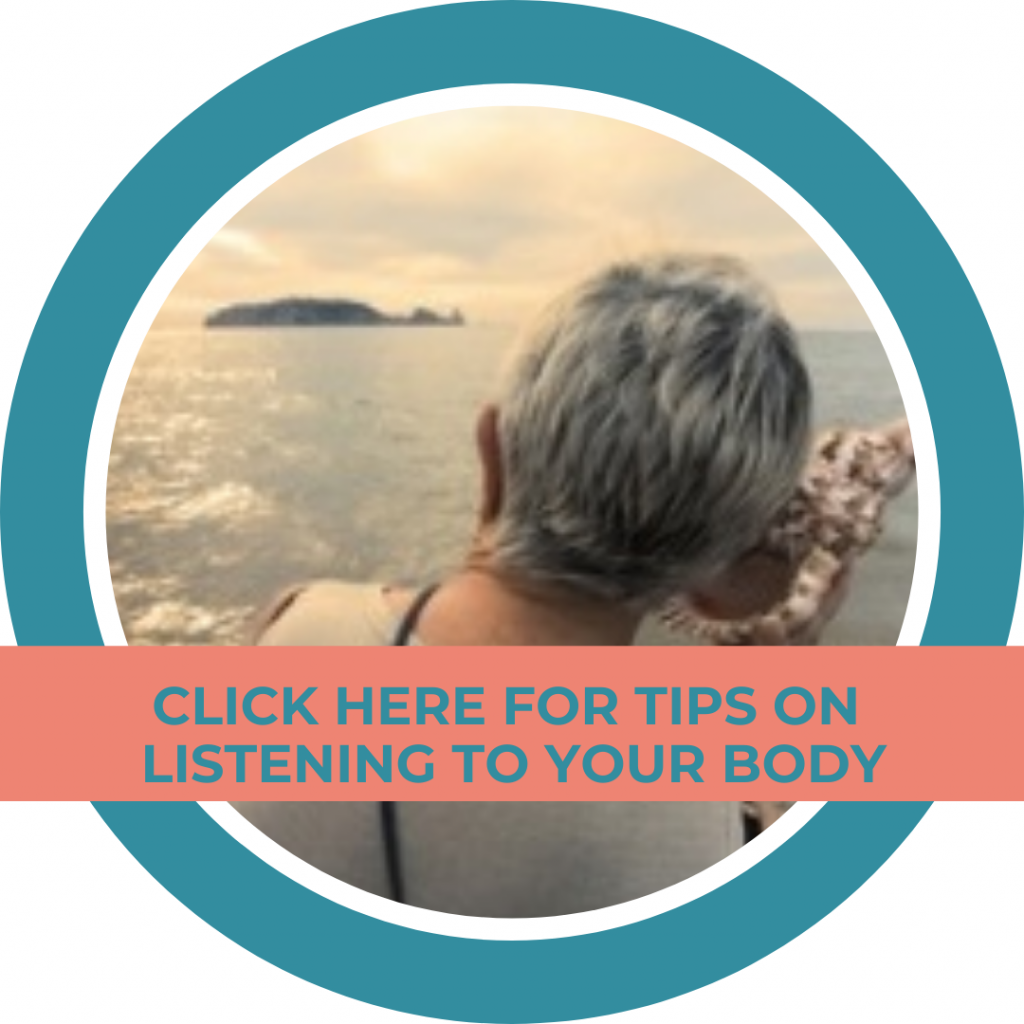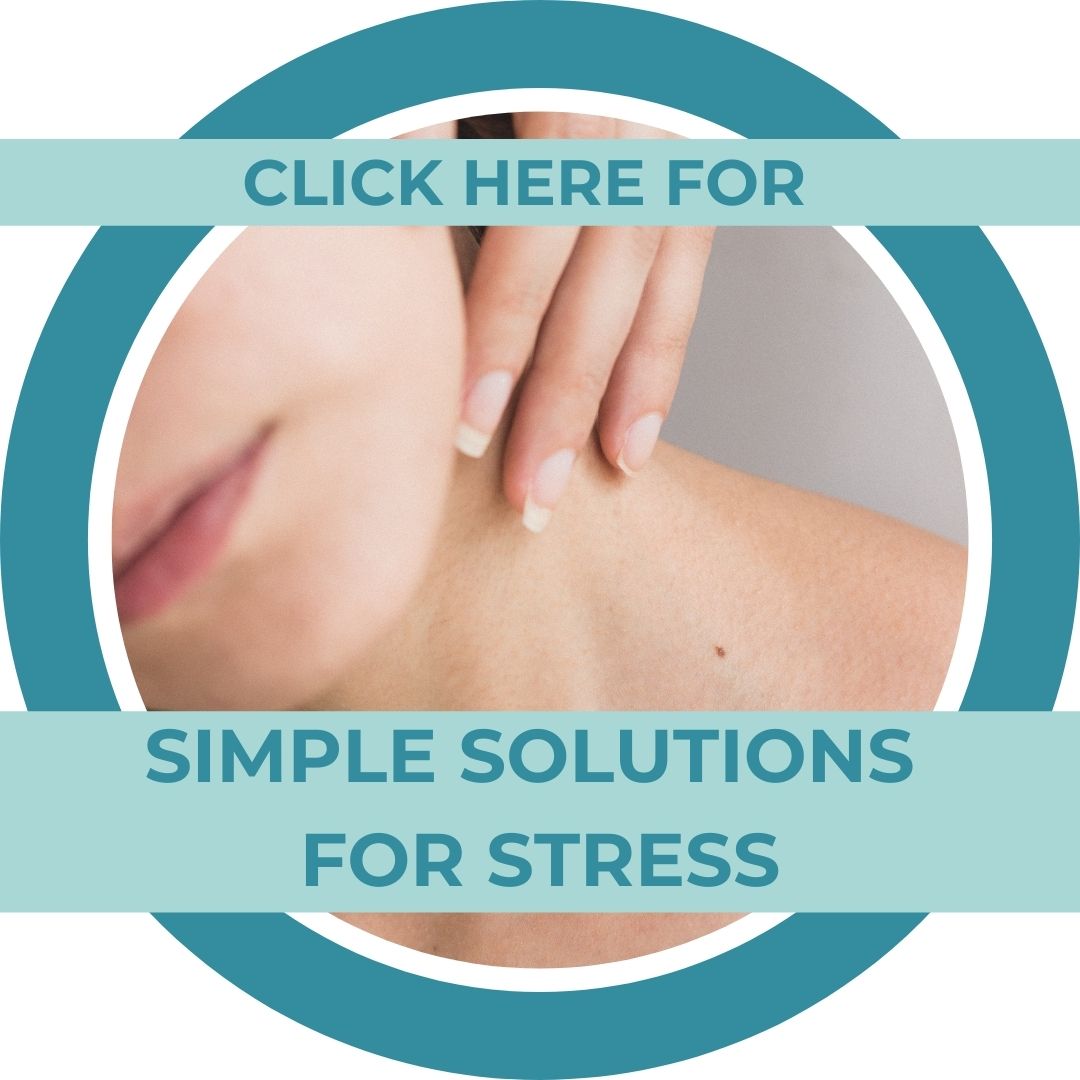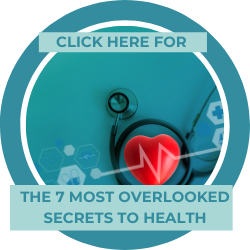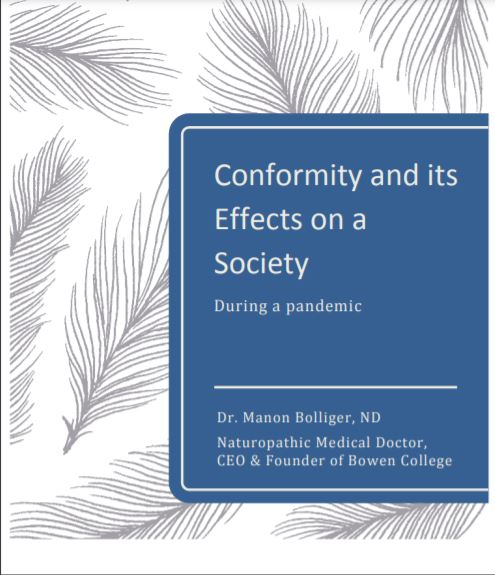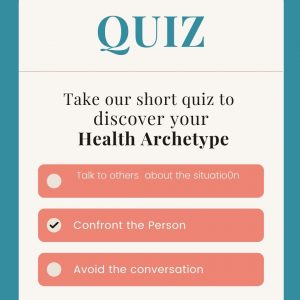Harnessing Healing: Equine Therapy’s Impact on Trauma Recovery with Melissa Jarzynski on the Healers Cafe & host Manon Bolliger
In this episode of The Healers Café, Manon Bolliger, FCAH, RBHT (facilitator and retired naturopath with 30+ years of practice) speaks with Melissa Jarzynski about the physiological benefits of equine-assisted therapy, such as improved nervous system function.
Highlights from today’s episode include:
Melissa Jarzynski 08:10
Well, so now that we know about the horses being able to read so much of the humans based off their sensory apparatus, right? So, a horse, just by smelling us from many, many feet away, will know your gender. Will know your mood. They can smell your mood through the hormones that we are secreting
Manon Bolliger
One of the things that I noticed, though, because I went to that to participate, to teach the humans the human part, and, yeah, if, let’s say, if a human being had pain in their hip and they were, you know, straddling the saddle a certain way, it would impact the horse.
– – – – –
Melissa Jarzynski
When ever you are on the back of a horse, that horse is dancing with the rider, and so it’s just like it takes two to tango if you have a lame horse, you know, let’s take a look at your riding biomechanics.
ABOUT MELISSA JARZYNSKI:
Melissa Jean Jarzynski, MSPT, HPCS, ESMLH, excels in integrating physical therapy with equine-assisted practices, particularly emphasizing trauma-informed care. As the owner of Happy Trotters, Melissa Jean PT and Stable Friendships Foundation and with over 19 years of expertise, Melissa is a board-certified Hippotherapy Clinical Specialist and is certified with PATH Int. and EAGALA.
Her pioneering spirit is most evident in her program, “Finding Peace in the Paddock™”. This groundbreaking work focuses on the interplay between human and horse heart rates, revealing significant benefits for those dealing with trauma, stress, and chronic pain. Her research in this area, though preliminary, has already begun to illuminate the profound effects of equine-assisted therapy. It’s not just about physical healing; Melissa’s work highlights the deep emotional and psychological connections that can be fostered between humans and horses, offering a new dimension to trauma-informed care. This unique blend of therapy and equine interaction is a testament to her innovative approach in enhancing holistic well-being.
Core purpose/passion: My core purpose/mission is to continue helping humans with the help of horses, but never at the expense of the horses.
Website | Facebook | Instagram | LinkedIn | YouTube
ABOUT MANON BOLLIGER, FCAH, RBHT
As a recently De-Registered board-certified naturopathic physician & in practice since 1992, I’ve seen an average of 150 patients per week and have helped people ranging from rural farmers in Nova Scotia to stressed out CEOs in Toronto to tri-athletes here in Vancouver.
My resolve to educate, empower and engage people to take charge of their own health is evident in my best-selling books: ‘What Patients Don’t Say if Doctors Don’t Ask: The Mindful Patient-Doctor Relationship’ and ‘A Healer in Every Household: Simple Solutions for Stress’. I also teach BowenFirst™ Therapy through Bowen College and hold transformational workshops to achieve these goals.
So, when I share with you that LISTENING to Your body is a game changer in the healing process, I am speaking from expertise and direct experience”.
Mission: A Healer in Every Household!
For more great information to go to her weekly blog: http://bowencollege.com/blog.
For tips on health & healing go to: https://www.drmanonbolliger.com/tips
SOCIAL MEDIA:
– Linktr.ee | Rumble | Gettr | Facebook | Instagram | LinkedIn | YouTube | Twitter |
About The Healers Café:
Manon’s show is the #1 show for medical practitioners and holistic healers to have heart to heart conversations about their day to day lives.
Subscribe and review on your favourite platform:
iTunes | Google Play | Spotify | Libsyn | iHeartRadio | Gaana | The Healers Cafe | Radio.com | Medioq | Audacy |
Follow The Healers Café on FB: https://www.facebook.com/thehealerscafe
Remember to subscribe if you like our videos. Click the bell if you want to be one of the first people notified of a new release.
* De-Registered, revoked & retired naturopathic physician after 30 years of practice in healthcare. Now resourceful & resolved to share with you all the tools to take care of your health & vitality!
TRANSCRIPT
Introduction 00:00
Welcome to the Healers Café. The number one show for medical practitioners and holistic healers, to have heart to heart conversations about their day to day lives, while sharing their expertise for improving your health and wellness.
Manon Bolliger 00:17
Welcome to the Healers Cafe. Today I have with me Melissa Jarzynski, and she excels in integrating physical therapy with Equine Assisted practices, particularly emphasizing trauma informed care. As the owner of Happy Trotters, Melissa Jean, what is this…and Stable Friendship Foundation? So this is your company, and Stable Friendship Foundation has over 19 years of expertise, and you yourself are board certified, certified hippotherapy clinical specialist, and you’re certified with PATH and another organization called Igala. So I think I’m going to not read anymore rather just welcome you, and if you want to, you know, explain what those terms mean exactly. I’m sure it would help a little bit.
Melissa Jarzynski 01:30
Well, thank you for having me. I’m very excited to be here and to meet you. So hippotherapy clinical specialist usually gets the most questions. People tend to know what a physical therapist is, hippotherapy, clinical specialist. Hippotherapy, here in the United States, and as we’re trying to reach terminology and around the world here, refers to physical therapy, occupational therapy, or speech therapy, intervention that is partnered with equine movement. So traditionally, most of the research in that, and most of the actual work that is being done on it is with children, but more and more we’re branching out into different areas.
Manon Bolliger 02:20
Okay, so, so tell me a little bit what like, what a day looks like for you, what do…what do you do in your therapies?
Melissa Jarzynski 02:32
So a day in our therapy setting would start with our finding piece in the paddock, which is a program that I’ve developed, and we’ve run a small case study off of where we join a group. It’s typically women, but of course, men are always welcome. It just happens to be women that most of the time sign up for it. They join me in the paddock first thing in the morning, and we circle up, and we do our deep breathing, and we do our meditation, and then we talk about our intention for our time with the herd. And all of this came about throughout my years of treating children like I said, most of everything that hippotherapy is based in is with pediatric clients. However, over time, I started noticing that I could take the children out. They would be, you know, on horseback, and the parents could probably be frazzled. They’re running late. You know, there’s many appointments, we would go for half an hour, we would come back. The parents were not on the horse, but they were simply in the environment, and all of a sudden you could feel that nervous system just …..
Read more...
come down. I was meeting parents that I hadn’t met before. Meanwhile, they are the same people, but their nervous systems had just reset. And it was something that I noticed over and over again, and I noticed it within myself as well that being around the horses did something very powerful for me. And some research came available in 2009 showing that a horse’s heart rate, which is much lower than a human’s, it’s usually about 40 beats per minute, and a human’s heart rate can actually co regulate each other, which we also know can happen between you know, moms and their offsprings, dads and their offsprings. Anyone in your environment right? And it just started putting the puzzle pieces together for me, of wait a minute, if we can create an environment that is safe for the horses, because we don’t ever want that co-regulation could work both ways, so we want to ensure that it is also safe and appropriate for the horses. But if we can do that, well, think about how powerful that would be to allow people to relax, and that is how finding peace in the paddock started. In the very beginning. It was all ground based work. There was no riding, and the results were great. Were fantastic. We were getting really well results on our quality of life questions, on our pain questions, and we were also getting the objectable data that people’s heart rates were coming down quicker and lower on the farm as compared to in their own homes. So that was just kind of giving us a nice base that, okay, this something is happening, right? But taking that a step further now and looking at what hippotherapy does, hippotherapy is very powerful, especially for those who are learning new movement patterns, which is why it’s really powerful for those children who are learning how to walk and they’re not quite ambulatory yet. Now imagine someone, you, I, anyone who’s had a traumatic event happen, a car accident, a trip and a fall, you know, a hip fracture that doesn’t quite get right. What about them? Right? We can also tap into their systems and their central pattern generator and their nervous systems, and we can give a holistic approach to dealing with something that really impacts a huge percent of our population and with chronic pain and chronic stress at an all time high. It’s…I feel like now is the time that this might be more accepted as an option as an alternative solution, as an out of the box thinking for a lot of people who might not have found some relief, and I…and I don’t say it’s a cure because, but I do think it’s a step in someone’s life. I think it’s a step in someone’s path, because I think it, you know, there’s going to be many teachers that come along the way that help us all get to a more place of peace and comfort. And if they can be a piece of anyone’s path, then I can’t think of a greater gift.
Manon Bolliger 07:34
And what do you feel like? I mean, obviously there’s, you know, people just going out in nature and or saying that they have a breath and they can breathe, you know, makes quite a difference to how the, you know, autonomic nervous system works and allows you to go into parasympathetic But what is it that you feel that the horses bring to it? Obviously, there’s more.
Melissa Jarzynski 08:08
Yeah.
Manon Bolliger 08:09
What is your understanding of that?
Melissa Jarzynski 08:10
Well, so now that we know about the horses being able to read so much of the humans based off their sensory apparatus, right? So, a horse, just by smelling us from many, many feet away, will know your gender. Will know your mood. They can smell your mood through the hormones that we are secreting. They are picking up so much information on us. They are what I call like little biofeedback machines for us humans. So that horse is going to know if your heart rate is high, he’s going to know if you’re fearful, and his behavior will act as such. That is very powerful for someone to first feel right, be in their bodies, feeling it and then getting that direct feedback from the animal. And because horses are prey animals, they are constantly in tune to that environment. They know if the smallest scent comes off from the way the wind blows. They know if the shade slightly moves, just a little bit, they’re in tune to all of that. So having the horse join you in those moments really can be very powerful. It can be powerful, positively and sometimes negatively, right? But at the same time, it’s also a learning experience. If it does become kind of what we would say, quote, unquote negative, right? Like, oh, that horse doesn’t want to come near me. And that’s typically not the truth, but that’s the first thing everyone says, the horse doesn’t want to come near me, and I think that’s just our own fear coming in, right? Our own fear of the rejection if the horse doesn’t like us. But like, I tell everyone, the horses are always reading our intentions. They will know if you’re fearful, yes, but they’re going to know if you’re fearful and angry, which is going to be a very different fearful curious. That fearful curious is kind of coming in with that childlike, that open mindset of like, okay, let’s see. Let’s see what this is going to hold. And so that is what the horse is. True on the ground, they will provide that all the time. As long as the horses feel safe and they’re within their herd, and you know, all of their needs are being met, the horses will 100% show up for the people on the ground.
Manon Bolliger 10:48
Yeah, very interesting. So what led you in this direction, or what’s your story, and how did you come across this? And obviously you’re creating a lot of it, I mean, so…
Melissa Jarzynski 10:59
Yes.
Manon Bolliger 11:01
Yeah. How did it all start for you?
Melissa Jarzynski 11:05
You know, just like everything else, it kind of starts on accident. I always had gravitated to to horses and animals in general. I love animals. I’m a big animal lover. Growing up, my family had a small cottage on an Indian reservation, the Seneca Hawk Indians up in Western New York. And whenever we would spend the summers there, I would get to see the horses that was on the Indian Reservation, and we would go on our trail rides. And it was lovely. And I just remember really wanting to be there all the time, and but then life happens, right? You go on, I was in physical therapy school, and I heard about hippotherapy. I thought, well, this is a no brainer, right outside with animals. Great. Um, how could that go wrong? Uh, over the years of treating children and just kind of observing the parents around me, I started also dipping into the grandparents. And, you know, the grandparents would sometimes bring the children, and I’d be watching and I’m like, Oh, you’re walking like you’re in some discomfort. Maybe we can try something, right? So it and that’s all it started. I just wanted to try to also see if we could help some of the grandparents, and we could. Fall rates were coming down, their get up and go tests were improving, like it was just something I was doing out of fun. And then I had to have a really serious moment when my father passed away suddenly, and I had to come to grips with just a lot of unresolved trauma that I had not dealt with that, you know, many of us, you don’t want to deal with it. It’s not fun, it’s not exciting, it’s some of the darkest work that you can do. And I started noticing how much I was gravitating back to my horses, back into the backyard, spending time with my horses, meditating and just simply being in that presence with them. All of a sudden, all these things started clicking. Of wait a minute. Can I show scientifically, right? Because I am a medical professional, I like…I like the science, and I do like research. I like to show that something works and is valid. And I started looking more and more into the research behind what could be happening. And once I saw that, I just said, how can we get this out to help more people, and what can that look like? And I started with the ground program, because that’s the easiest for anyone to replicate. A horse tends to lose its value in the world if it’s not able to be ridden, which means they’re often discarded of and for me, showing that these horses still have a purpose. They don’t need to be ridden, for us to place value on them, just being in their presence is a great value to us as humans. Was very powerful for me as well, and it was a very personal mission to I would, you know, helping people is, of course, my passion, but ensuring that it doesn’t come at the cost of any of these beautiful creatures that we’re so we should be so grateful to partner with is, is the cornerstone, right? Those, those two things are the ying and the yang. They go together and that started it. And now, yes, it does move on to the mounted component. Because, you know, it’s been 20 years I’ve studied how equine movement can facilitate different movement patterns in humans.
Commercial Break 14:53
What would your life be like if you were pain free? If you were one of the millions who suffer from chronic pain? Pain, the thought of just one day without it may seem impossible. This is often because conventional medicine tends to fall short in the treatment of pain, opting to prescribe pills or recommend surgery rather than getting to the root cause of the problem. But if you are suffering with emotional or physical pain, there is hope. Join the founder and CEO of Bowen College, Manon Bolliger, live online for your body mind reboot. Learn how to listen to your symptoms and get to the root cause of your pain, plus be trained in basic Bowen therapy moves so that you can reboot your body for optimal health. You don’t have to live in pain. You can heal stop the pain pill cycle by visiting www.yourbodymindreboot.com to learn more and to register.
Melissa Jarzynski 15:55
Uh, and chronic pain and addiction is, is where it’s everything is pointing in that direction.
Manon Bolliger 16:14
So, well, can you, I’ll share a little bit about my experience with this, but I, I’d love to, you know, hear more also about your experience with equine but so I do something called Bowen Therapy, and we have a college called Bowen College. And so, we teach humans how to do this to other humans, right? Practitioners. But many people have asked, you know, can it be done on animals, and can it help my, you know, my dog, and what about my cat and then, of course, it came to the horses. And now there’s actually schools that focus on horses receiving this therapy. One of the things that I noticed, though, because I went to that to participate, to teach the humans the human part, and, yeah, if, let’s say, if a human being had pain in their hip and they were, you know, straddling the saddle a certain way, it would impact the horse. So, you could help fix the horse, but if you didn’t help fix the human, then it would reproduce itself, because there’s some real symbiosis between the two. So I was, I was really shocked by this, because it was, I mean, it’s not that surprising, but it’s so visual, and these grand, beautiful animals responding, it’s quite, it’s quite something to see. So yeah, could you speak about that a little bit in your experience?
Melissa Jarzynski 17:59
Yes, and, and I love that you saw that and brought that up, because it is not something people think about. In especially in the show world, it is always blamed on the horse if there is an imbalance. But I’m always like, but what about the rider? Because you are a dance partner team. When ever you are on the back of a horse, that horse is dancing with the rider, and so it’s just like it takes two to tango if you have a lame horse, you know, let’s take a look at your riding biomechanics. Let’s take a look at your attack, that chronic pain that your horse is in, maybe doesn’t need to be what it is. It may be, there’s some solutions, but it’s typically not looked at like that, which is very interesting to me. But you know, I do believe, just like everything else, that will change. But yes, I had one woman, and she was, she’s still with me today, and she’s amazing, and she started with me in 2017 and anytime Linda’s hips were out of balance, I knew, just by the way Frankie was walking, and I would just stand behind and I’m like, so Linda, what’s going on with the hips today? And so we would work with it there, work with the steps. Because by helping Linda, I was also helping Frankie right, by helping break through those moments with her, helping break up whatever movement pattern she was trying to restrict. Frankie was like, showing us like, hey, this this area needs some attention, right? And it just takes someone to step back and look. But it’s also knowing how that horse normally walks and how that horse normally moves. And I would imagine. So many people would pick this up very quickly if their mindset was just thinking about it. Because we all have pets in our life, right? And if you see your dog and he’s he’s looking a little different, you’re going to be like, Oh, what’s going on with him today, right? But for some reason, when it comes to the horses, we become so focused on our performance and what that horse is going to do for us, we tend to forget the other aspect of it, um, but the horses are always showing us.
Manon Bolliger 20:31
Yeah, that makes sense, yeah. I mean, I guess horses are used a little bit differently, right? So I guess that’s why, right?
Melissa Jarzynski 20:41
Exactly. It’s yeah, and it’s so it’s always interesting. I have a retired, my retired business partner, Smokey is in the back with Linus, our donkey. And everyone always asks the first question is, like, so did you ride him? I’m like, no, no. And they it’s always interesting. But I also have a dog and a cat. No one asks, like, if I’m showing them, or, you know, that animal doesn’t have to perform or do anything, but the horse and the donkey, well, they better get to work.
Manon Bolliger 21:12
Very interesting, yeah. Well, you know, I think that actually is…it’s cultured into us since forever.
Melissa Jarzynski 21:18
Yeah, 100% right.
Manon Bolliger 21:21
It’s like, you know, we’re still part of slave labor ourselves, right? So it’s kinda the same,
Melissa Jarzynski 21:27
Yeah, it is. It’s so true. And not growing up in like the the show circuit and all of that, my experience from an Indian reservation is very different than the barns that I experience here, which also really shaped my perspective on how I view the horses as my partners, you know. They will never be a tool for me that, you know, the tool is, you know, something completely different. And the horses also always have the right to say no, because that’s we all have days, and I’ve learned that if the horse says no, there’s usually a reason and it needs to be listened to. Otherwise, honestly, the whole therapy just isn’t, isn’t going to work. If the horse checks out, there’s nothing that no one’s going to gain anything from that moment.
Manon Bolliger 22:30
So, but what does, let’s say a person comes in with addiction, for example, or, I mean, pick whichever one you want. It doesn’t matter. Whatever example comes to mind, but, but how do you…how does it? What happens? Like?
Melissa Jarzynski 22:49
Sure, so I have some really interesting medically complex trauma survivors who have a lot of autoimmune disorders happening, a lot of flare ups, a lot of symptoms coming from different places that people just can’t quite put together right? Their body is telling them something, and they are driving themselves batty by going to all the different doctors and collecting as much information as they can. And so we come in, the first thing we do is we sit in the paddock with the horses around us, and we talk a little bit, right? I need to hear all about the history, how it started, as far as much as that person wants to share. In that time, I am listening to the person, but I am also watching what my herd is doing around me. They will very much tell me where that person is at, um, if that person’s nervous energy, if their nervous state is so high, sometimes the entire herd will go to the other side of the paddock. And I’m like, okay, I get it. You know, we we have some work to do, and that’s the horses can do that. And this is all for me, taking it in the people typically don’t quite realize what’s happening around them, but I do point it out at certain points that I am watching them. I’ll point out sometimes if a horse just lays down, I will talk about the significance of that, because prey animals don’t just lay down with people unless they truly feel safe. Like that is a beautiful gift if those animals want to sleep or rest near you. So I’ll always point out those little observations, and then slowly, we’ll kind of make our way out to the herd. I typically then have an idea of what horse will partner best with what human but sometimes I’m wrong, and sometimes it’s like the least unlikely pair, and then we talk about, okay, would you like to get on? Because that can be, especially for anyone who’s had trauma, that can be very scary. You are on this very big animal, and you don’t have total control. And what I ask them to do when they’re on the horse is to surrender even more, because I don’t want their body blocking. I don’t want that stiffness. I want them to completely relax, so they can feel what the horse is trying to give them. And so that, I mean that takes you know that this is a trend from like three months, right, typically, and in that time, I’m also talking with their mental health provider, because I am a physical therapist, and I understand a great deal, but so much of what happens is also emotional, that every person that comes into my care also has the mental health provider, so that we can tag team it up, and there are emails back and forth to make sure that we’re we’re doing the best that we can for the client, and that no story is going left unturned for them. Which, you know, a lot of times, a lot of stones get left unturned when talk, when they’re dealing with so many different people. And so that’s very that’s very important to me, because, again, we want to create a circle around these people and give them the support that they need when they need it.
Manon Bolliger 22:50
I mean, it makes sense. What you’re saying for sure.
Melissa Jarzynski 26:32
Yeah.
Manon Bolliger 26:35
So, so then with time, I’m I’m assuming the client starts to have its own understanding of the relationship that the horse is having with them.
Melissa Jarzynski 26:51
Yeah, they they do. And what’s interesting is, if a period of time goes by, I’ll get, you know, the text or the email, like, I really feel like I just need to come and sit with the herd, and I get it. And so that is something that I am hoping to offer, that people can just come sit in a safe space and be with the herd, right? I understand it again. We’re all on our own journeys, and none of them go straight up right like there’s rocks and plateaus and, you know, floods and all these things happen on but to have that, that another tool in their back pocket and one that they have found effective, that’s the greatest compliment to any horse in the world. You know that they can, they can do that for people. And I have one woman who wants to come and she has the dream of writing a book, and she wants to write the book in the paddock, and I think it’s beautiful.
Manon Bolliger 27:59
Interesting. Yeah. Oh, wow, yeah. My, I’ve had a little bit of experience with horses, not, not much. But my daughters both rode when they were small. They really connected to that, not so much later, just circumstances and, yeah, all of that, but not, you know, not personal about the dogs and and my relationship was more therapeutic. You know, if one of them injured themselves, or anything like that, if I was there available, though, you know, there’s lots of different provincial rules and in BC, we’re not allowed to even look after our own horses, you know. So that’s very interesting, but that’s not the case like in Ontario, so it changed. But my main experience with horses was in Mexico, and I wanted to do, you know those images where you’re on a horse by the ocean and everything feels like a flow, and I spoke a little bit of Spanish, clearly not sufficient, because I said yes to an eight hour. I think it was a combination of a gallop and this and that, and they didn’t have a saddle for me, so it was on these difficult ropes. And surrender was the right term, because there was no choice. You know, it was very sore.
Melissa Jarzynski 29:41
I can only imagine.
Manon Bolliger 29:45
But the the end result, like I could feel the the connection with that horse, because the horse didn’t know any better, you know, that they that they wouldn’t have the right outfit for me to be comfortable. Anyway, there’s definitely a connection that happens.
Melissa Jarzynski 30:06
Yeah, yeah. And the most of the time when I put someone on, they will just be on a bareback pad. There is no saddle. Again, we want to keep them as close contact with the horses as possible.
Manon Bolliger 30:19
A little better than the ropes.
Melissa Jarzynski 30:22
A little bit. Yes.
Manon Bolliger 30:25
That I could have handled.
Melissa Jarzynski 30:29
Yes, they’re, they’re pretty, they’re pretty nice and cushy, you know, um, but yeah, so because the saddle so many times, can block the motion or change the motion, yes. Sometimes saddles are great, especially in the beginning. If someone isn’t quite ready to fully relax and someone and they feel like they would prefer the saddle, well, then we start there, right, and we work our way down. But yeah, the bareback pads are amazing, because you feel everything with those horses. And that’s how I learned how to ride, was just on a bareback pad. And even if I want to go out for a trail ride or anything here, I will go on a bareback pad. And everyone here thinks that that’s crazy. You should be on a saddle. And I’m like, You guys are all crazy because I can feel everything underneath my horse, if she twitches or moves I know, like right away, um, and I just, it’s just how I prefer, yeah.
Manon Bolliger 31:33
In between, right?
Melissa Jarzynski 31:35
Correct, correct, yeah.
Manon Bolliger 31:38
Anyway, so listen to our time’s almost up. Is there anything else you’d like to share that we haven’t touched upon in your field of work that, yeah, that you want people to know about?
Melissa Jarzynski 31:51
I would say yes. There is now research coming out on how hippotherapy has helped those with rheumatoid arthritis as well as MS. I’m hoping that we’ll see one on gastroparesis very soon, because I have seen some case studies with that. I think that if it is something that anyone is open to, to look for a provider, and if they ever need help finding a provider, email me. I am happy to put you in touch with whomever I can, wherever I can, because that’s how we all help and support each other, and I would be honored to help anyone, whether you’re in British Columbia or, you know, Australia, there are practitioners all around the world starting to to do this, and it’s really, really exciting.
Manon Bolliger 32:51
Okay, well, thank you so much for sharing your knowledge and your passion.
Melissa Jarzynski 32:55
Thank you so much for having me.
Ending
Thank you for joining us at the Healers Cafe. If you haven’t already done so, please like, comment and subscribe with notifications on as I post a new podcast every Wednesday with tons of useful information and tips for natural healing that you won’t want to miss, go to DrManonBolliger.com/tips for more tips
* De-Registered, revoked & retired naturopathic physician, after 30 years of practice in healthcare. Now resourceful & resolved to share with you all the tools to take care of your health & vitality!
